Lebanese Garlic Sauce (Toum)
Updated Sep 29, 2023
This Garlic Sauce (Toum) is a popular condiment in Lebanese restaurants served often with chicken; made with only 4 ingredients: garlic, oil, lemon and salt
This post may contain affiliate links. Please read our disclosure policy.
Toum is a Lebanese garlic sauce that’s actually more like a spread because of its thickness. It’s super popular to spread it over Shish Tawook, grilled chicken, shawarma, rotisserie chicken and many other Middle Eastern dishes. It’s basically a slow and steady emulsion process of garlic and oil and it’s utterly heavenly!
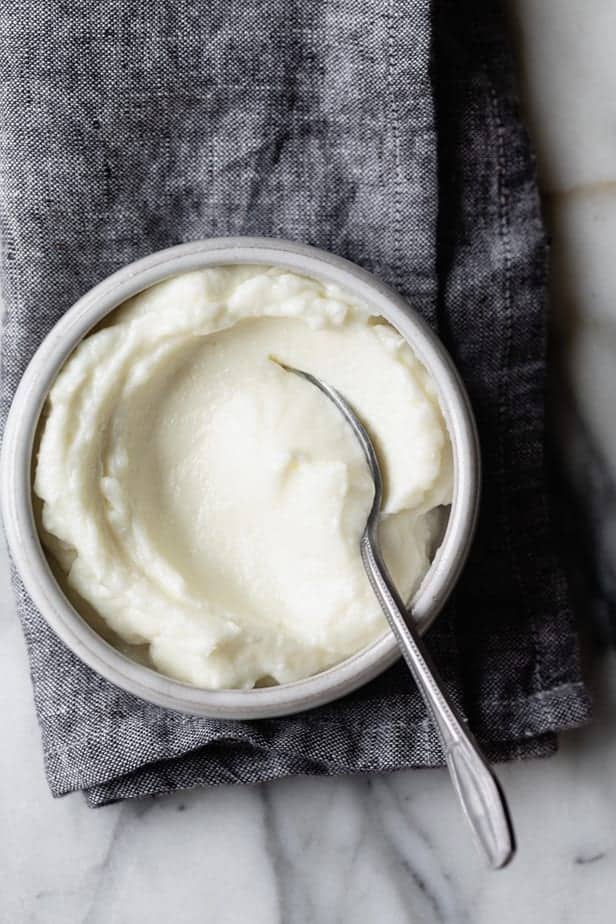
I used to think the proper way to make toum involved mayonnaise or egg whites. To me, it sounded like such a high-calorie sauce to be making at home and I saved it for dining out only. But then I discovered Maureen Abood‘s recipe for Lebanese garlic sauce, and it uses 4 ingredients: garlic, oil, lemon juice and salt. I was sold! It’s flavor-packed, vegan and easy-to-make!
What is garlic sauce made of?
- Garlic: The most important part of the recipe is the garlic. Find the freshest garlic bulbs you can find. Test them for firmness to make sure that they have the best consistency and flavor. You will need 1 cup of peeled garlic. You can freeze the remaining garlic.
- Oil: You can use canola oil, vegetable oil, safflower oil, grapeseed oil or any other neutral oil you prefer. While avocado oil is neutral and won’t change the taste of the sauce, it will give it a yellow/green color. I do not recommend using olive oil because it will change the color of the garlic sauce and lend a stronger flavor than than the neutral oil. You want the garlic flavor to stand out more than the oil flavor. You’ll need 3-4 cups of oil.
- Lemon juice: The lemon plays a supporting role in the Lebanese garlic sauce, and helps to combine and emulsify so the oil doesn’t overpower the garlic. I use ½ a cup but you can decrease according to your taste preference. The lemon juice acts as a binder, so don’t leave it out.
- Salt: The salt helps to finely grate the garlic by adding traction to garlic’s natural wetness in the beginning of the processing. Plus, it helps to flavor the sauce.
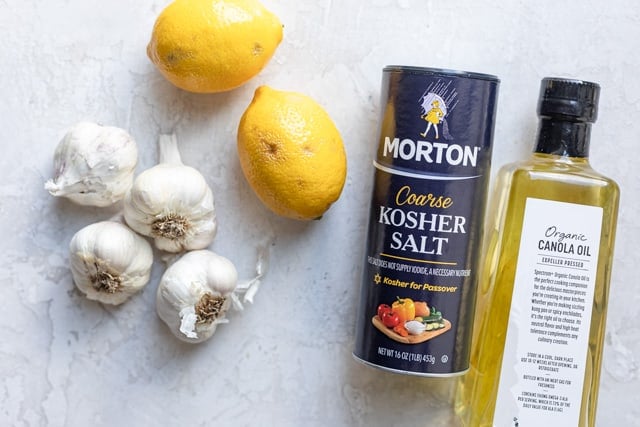
RECIPE VIDEO TUTORIAL
How to make garlic sauce
Peel one cup of garlic cloves, which should be about 4 garlic bulbs. You can also buy pre-peeled garlic, but make sure it’s very fresh. I sometimes ask my local supermarket to peel it for me with their industrial machine, so I know it’s freshly peeled.
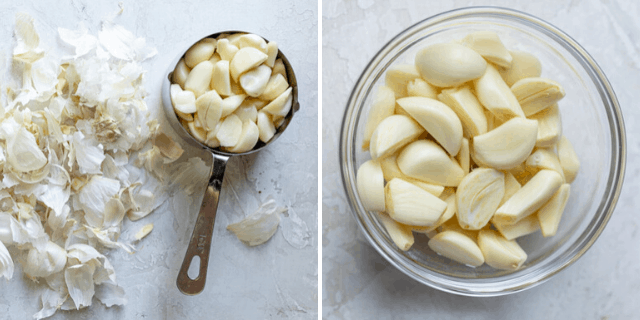
While our ancestors made garlic sauce by using a mortar and pestle and whisking patiently, that is a laborious process. I highly recommend using a food processor for the quickest way to make a light and airy texture. Place the peeled garlic and the kosher salt in the food processor and blend until it’s well minced, scraping down the sides as necessary.
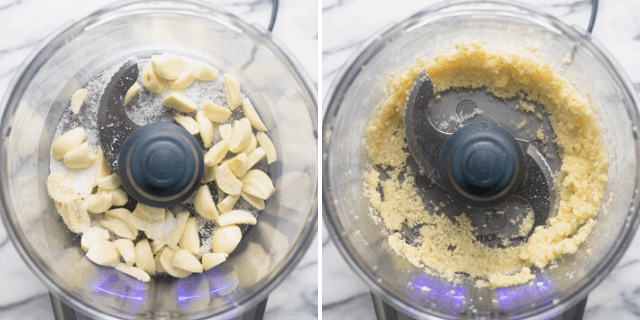
In order to emulsify, just like making pesto, it’s important to run the oil very slowly in a thin stream and small batches at a time. When you first introduce the oil, start with only one tablespoon of oil. This gives the oil ample time to blend well into the salted garlic. You can’t really rush the process.
Make sure to scrape down the sides so that all the minced salted garlic gets well incorporated into the oil. After scraping down the sides, you can slowly add another tablespoon of oil. This initial introduction of the oil to the garlic is the most important step of making homemade toum.
You want it to look creamy and emulsified, like the image on the left, before you can speed up the process. Once it becomes airy and fluffy, it’s your cue to continue making the garlic sauce by alternating between pouring in the oil and pouring in the lemon juice. After about 15 minutes, it will look like the image on the right.
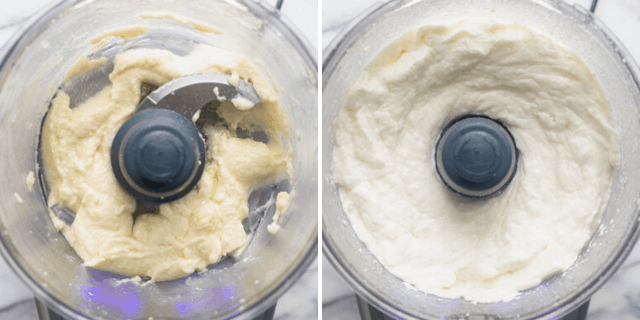
To let the garlic set, I cover it with a paper towel and store in the fridge, and let the flavors set in overnight before enjoying it. The paper towel allows some of the moisture to wick away while setting in the flavors. You can remove the paper towel after 24 hours and just cover it with a tight-fitting lid.
The end result is a light, airy, totally garlickly and beautifully creamy Lebanese garlic sauce. Its smooth texture and aromatic taste makes it so addictive to enjoy in so many ways!
Tips for Making Homemade Garlic Sauce
- Remove the green sprout from inside the garlic. This step is not necessary, but by doing so, it ensures that you remove the oldest part of the garlic to be left with the freshest whitest part of the garlic. The result in a less bitter sauce, so it’s worth the step if you have time.
- Soak the garlic in ice water for 30 minutes for a less potent taste. Some readers have mentioned that the taste of the garlic was really strong. One way to reduce that potency is by soaking the garlic with ice water. Make sure to dry them thoroughly though afterwards if you do this.
- Make sure to alternate the lemon juice with the oil. I’ve had the garlic sauce fail on me a couple times when I tried leaving the lemon juice until the end, but the oil becomes too heavy to support the garlic that way. The lemon juice helps keep the consistency light, so I suggest alternating it as soon as the mixture is initially emulsified.
- Don’t use a blender. It’s really difficult to get the mixture to emulsify in a standard blender or immersion blender. A blender also doesn’t allow the ease of slowly drizzling in the oil while the motor is running over a large surface area. I do not recommend a blender.
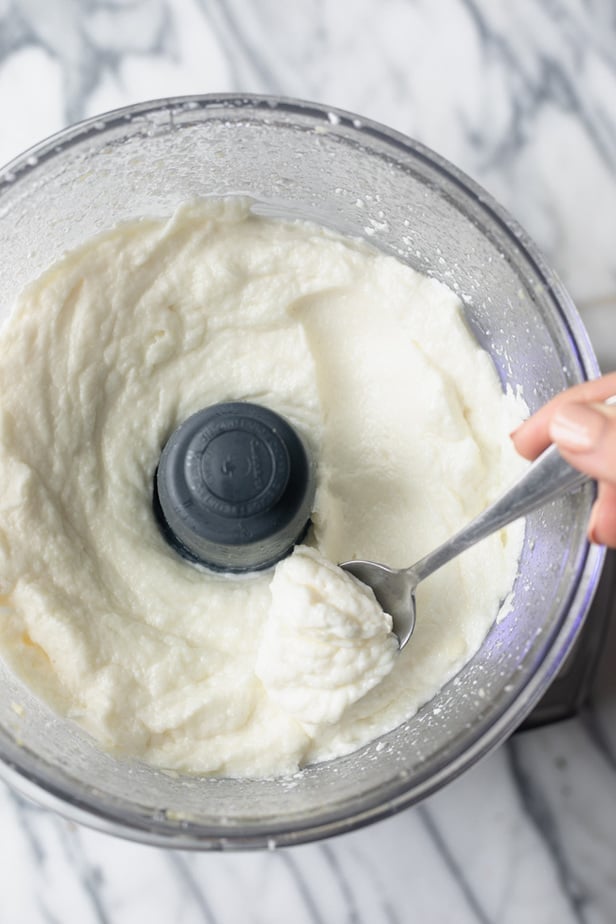
What to eat with garlic sauce
The possibilities of how to serve toum are endless. I mostly enjoy it with grilled meat and chicken. But it works really well with grilled fish, in sandwiches, in pasta. It also works as a dip with pita bread and crackers. Or you can use it as a base for a garlickly salad dressing. Here are some great recipes that work with the garlic sauce.
- Shish Tawook (Chicken Skewers)
- Broccoli and Shrimp Pasta Alfredo
- Chicken Shawarma Salad
- Roasted Cauliflower Pitas
- Shawarma Pita Pizza
Frequently asked questions
If you keep it in an airtight container, this garlic sauce will last 3-4 months in the fridge! After that time, the strength of the garlic will start to fade.
You want to use a neutral oil like canola, vegetable, grapeseed or safflower oil. Olive oil will make it more dense and the color won’t be as bright and white.
It has happened to me a couple of times when I left the lemon juice at the end or when I added the oil too quickly. So it’s important to alternate the oil and lemon juice and don’t rush the process. If the mixture didn’t get fluffy and looks more liquid, it’s possible that it didn’t emulsify.
I would recommend adding 1-2 boiled potatoes to the food processor and allowing the potato to help emulsify it. In that case though, be sure to only store the garlic sauce no more than 7-10 days.
Before making the garlic sauce, you can soak the garlic for 30 minutes in ice water. After making the garlic sauce, you can whisk in some lemon juice to mellow down the flavor. I find it mellows down with time though.
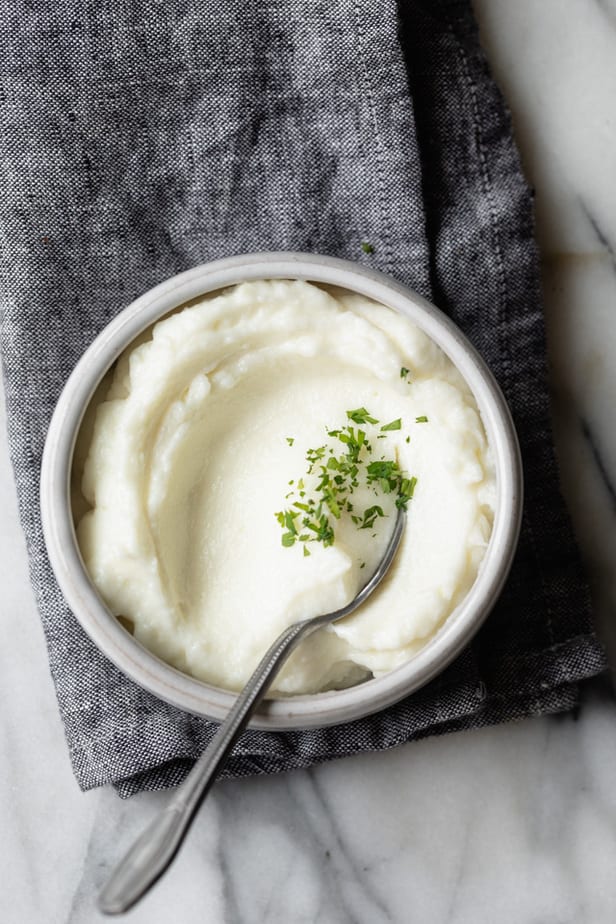
More Lebanese Recipes
- Tahini Sauce
- Homemade Labneh
- Ful Medames
- Peas and Carrots Stew
- Lebanese Falafel
- Mujadara
- Kousa
- Lebanese Freekeh with Chicken
If you’ve tried this healthy-ish feel good Lebanese Garlic Sauce recipe or any other recipe on Feel Good Foodie, then don’t forget to rate the recipe and leave me a comment below! I would love to hear about your experience making it. And if you snapped some shots of it, share it with me on Instagram so I can repost on my stories!
This Garlic Sauce Recipe was originally published on July 11, 2018. I’m updating the post to include step-by-step photos and a video tutorial. Here’s the original photo!
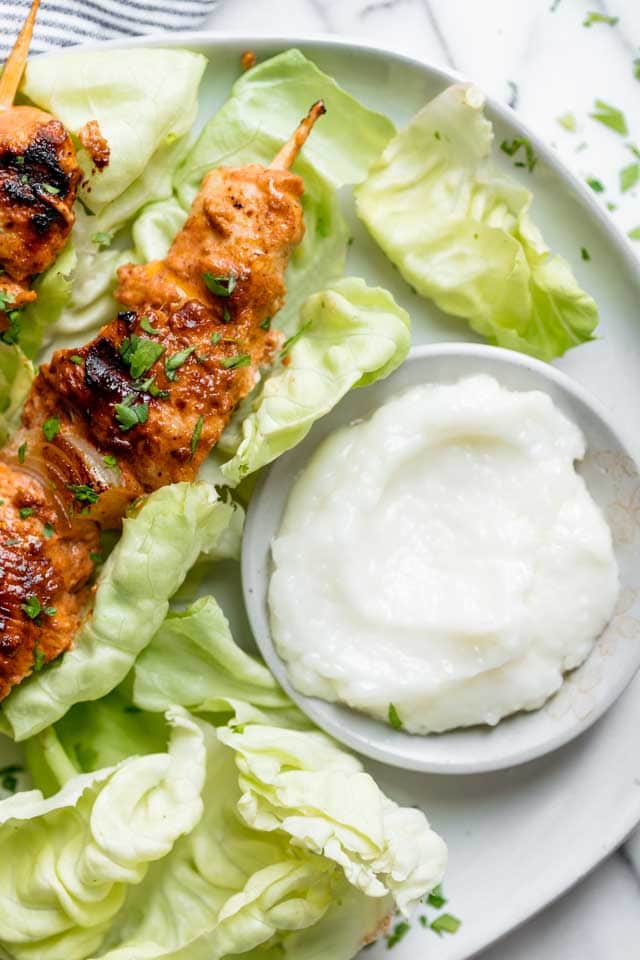
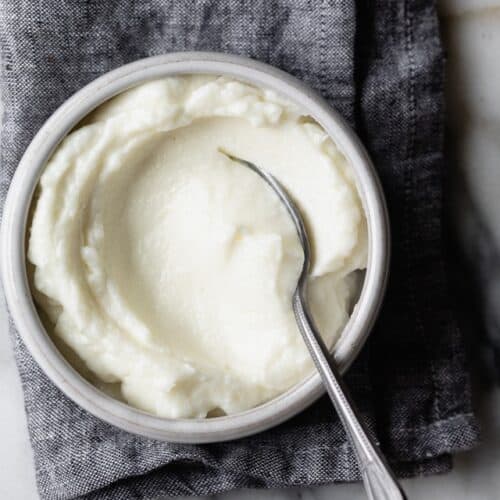
Lebanese Garlic Sauce (Toum)
Video
Ingredients
- 1 cup garlic cloves peeled
- 2 teaspoons Kosher salt
- 3 cups neutral oil such as vegetable or canola
- ½ cup lemon juice
Instructions
- Slice the garlic cloves in half lengthwise and remove any green sprouts.
- Transfer the sliced garlic cloves into a food processor and add the kosher salt to the garlic cloves. Process for a minute until the garlic becomes finely minced. Make sure to scrape down the sides of the food processor afterwards.
- While the food processor is running, slowly pour one to two tablespoons of oil, then stop and scrape down the bowl. Continue adding another tablespoon or two until the garlic starts looking creamy.
- Once the garlic looks emulsified by the few tablespoons of oil, increase the speed of pouring the oil and alternate with the ½ cup of lemon juice until all the oil and lemon juice is incorporated. This will take about 15 minutes to complete.
- Transfer the sauce into a glass container and cover with a paper towel in the fridge overnight. Makes about 4 cups.
- The next day, replace the paper towel with an airtight lid and keep in the fridge for up to 3 months.
Equipment
Notes
Nutrition
Nutrition information provided is an estimate. It will vary based on cooking method and specific ingredients used.






Comments
I am so happy I found this recipe! I have loved a certain garlic spread/dip from a popular grocery store for years and have been looking to replicate it, and I have to say… I followed your recipe to a T and it is even better!!!
Yay!!! That makes me so happy to hear! Thank you so much, Sarah!!
Fantastic! Wow! Great instructions, too!!!
Aww, so happy you found them helpful! Thank you!!
Made this tonight. Was a bit lazy and used my hand blender in a 1 quart glass Pyrex measuring cup, used my emulsion hand blender and it came out fantastic!
Wow, thanks for sharing!
This is absolutely delicious! I used refined avocado oil and it worked great and tastes amazing. I soaked the garlic for about twenty-five minutes and the sauce is still pungent but not overpowering. It was perfect with my chicken shawarma. THANK YOU for this recipe! 😀
Amazing! So happy you loved it, Joelle. Thank you so much!!
I made this sauce and it is one of the best sauces I have ever made or tasted. I can’t get enough of it. I put it on my meat, on my sandwiches, on my toast. If I thought it would taste good, I would put it on ice cream lol. I highly recommend people try making it. It is delicious.
Aww, that makes me so happy to hear!! I’m glad you love it, Sheri! Thank you!!
See All Comments